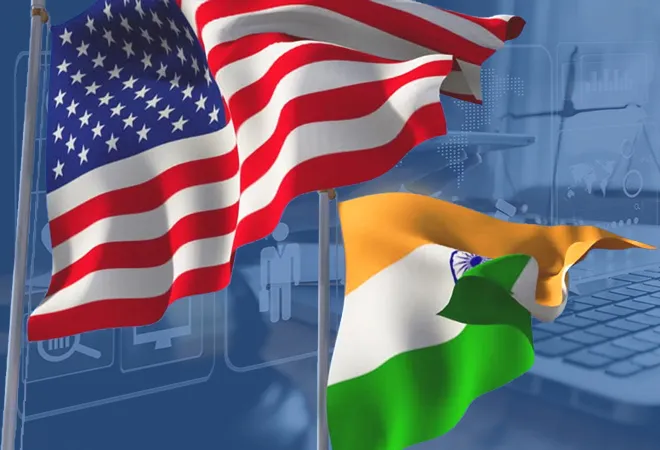
There has been a consistent elevation and expansion of the India-US strategic partnership in the past two decades. Besides the growing trade numbers, the two countries have institutionalised their relationship with regular dialogue formats and engagement architectures led by the 2+2 format at the highest levels on either side. Beginning with the New Framework for India-US Defense Relations in 2005 and the resultant intensification in defence trade, joint exercises, personnel exchanges, collaboration and cooperation in maritime security and counter-piracy, and exchanges between each of the three services, the bilateral relationship has touched newer heights with Comprehensive Global Strategic Partnership initiated in 2013 and Major Defense partner status since 2016. Despite these achievements, the bilateral relationship continues to advance and adapt to the new geopolitical and strategic realities of today. The latest addition to the expanding list of India-US ties has been the potentially consequential Initiative for Critical and Emerging Technologies (iCET) signed between the two sides during NSA Ajit Doval's United States (US) visit to Washington from 30 January - 1 February 2023.
< style="color: #0069a6;">The iCET was conceived as an initiative which will be spearheaded by the National Security Councils of the two countries to expand partnership in critical and emerging technologies.
< style="color: #163449;">iCET
The latest agreement between India and the US in the form of the iCET is a follow-through on the announcement made by the leaders of the two countries during the third Quad Leaders’ Summit held in May 2022. The iCET was conceived as an initiative which will be spearheaded by the National Security Councils of the two countries to expand partnership in critical and emerging technologies. The two most prominent aims of the iCET are to elevate and expand strategic technology partnerships and defence industrial cooperation between India and the US. The iCET is likely to supplement these bilateral agendas.
In the emerging and critical technologies domain, the iCET envisages an ‘innovation bridge’ with India by joining six of India’s Technology Innovation Hubs to support at least 25 joint research projects in areas such as AI and data science and apply its gains to areas such as agriculture, health, and climate. In May 2022, India and the US had also pledged to expand cooperation in new defence domains such as space and cyber besides a promise to launch a dialogue on AI. In the expanding spectrum of India-US defence cooperation, technology together with its core and ancillary elements, is rapidly situating itself as an indispensable reality. In the defence sector, iCET is expected to bolster cooperation in AI and military equipment. For both countries, weaving technology with existing defence and security cooperation reflects a recognition of today’s rapidly shifting geostrategic environment as well as the need to prepare for a tech-centric future. This is specifically true for the Indo-Pacific than other regions where one of the most intense competitive one-upmanships is likely to play out with China’s rapid advances in the field and the US determined to maintain a considerable tech gap with China together with its Indo-Pacific partners.
The iCET also reflects an important characteristic of the emerging tech order in the Indo-Pacific which locates critical and emerging technologies within an environment shaped by issues of design, development, governance, democratic values and human rights. Open, accessible and secure technology based on mutual trust, confidence and strong institutions are expected to foster cooperation envisaged within the iCET. To that end, the iCET is also intended not just as a conduit for critical and emerging technology cooperation but is linked with the broader issues of the Indo-Pacific like mutual trust, confidence and an ecosystem of technological cooperation.
< style="color: #0069a6;">The iCET also reflects an important characteristic of the emerging tech order in the Indo-Pacific which locates critical and emerging technologies within an environment shaped by issues of design, development, governance, democratic values and human rights.
At the institutional level, the iCET seeks to create functional and cooperative technological linkages between the U.S. National Science Foundation and the Department of Science and Technology of India, particularly through a new invitation arrangement for advancing partnership in the areas of artificial intelligence, quantum technologies, and advanced wireless technologies. Among important mechanisms to foster cooperation within the iCET is the decision to establish the joint Indo-US Quantum Cooperation mechanism which will bring together a consortium of leading researchers and quantum industry players in India and the US.
The iCET is also intended to circumvent bureaucratic obstacles and red tape which often hinder technological cooperation between the US and India. The hitherto sluggish progress in the DTTI is a testimony to the mismatch between the two sides expectations, domestic legislations in the US and cooperative mandate in critical technological sectors. Despite India being accorded the Major Defense Partner status by the US few years back as well as the three foundational agreements signed between the two sides, there remains significant limitations on tech transfer in sensitive domain as the US maintains core distinctions between technology transfers to allies and non-allies. However, the iCET, in some ways, seems to be intended to overcome precise impediments in high-tech and sensitive-tech transfers between India and the US. Towards achieving this, the iCET has announced a new bilateral defence industrial cooperation agenda which seeks to provide momentum to defence technology cooperation with a focus on joint development and joint production. One of the kick-starter projects under this vision is collaboration for jet engines. Importantly, in this regard, US is considering proposal from General Electronic (GE) to jointly produce jet engines for indigenously manufactured fighter aircraft in India. This includes the GE-414 engines which has been earmarked by India to power its indigenous Light Combat Aircraft (LCA)-Mk2 and the fifth generation Advanced Medium Combat Aircraft (AMCA). As such, the iCET is expected to buttress the Defence Technology and Trade Intiative (DTTI) as earlier efforts to co-develop jet engines under the project fizzled.
< style="color: #0069a6;">The iCET has announced a new bilateral defence industrial cooperation agenda which seeks to provide momentum to defence technology cooperation with a focus on joint development and joint production.
Finally, through the iCET, the US seeks to integrate efforts in sustaining leadership and resilience in production and supplies of semiconductors with India. The announcement by the US Semiconductor Industry Association to partner with the India Electronic Semiconductor Association as well as invest here are important steps in the direction. Given the implications of chip shortage on global manufacturing, security and everyday lives of people, exacerbated by the pandemic-induced disruptions as well as the prolonged Russia-Ukraine war, the Biden administration has already taken stringent steps domestically and has waged a ‘chip war’ with China with its CHIPS and Science Act of 2022 which not just increases funding in semiconductor manufacturing but also brings legislations to regulate investments and participation in Chinese semiconductor companies by US companies and people. The iCET seeks to create external balancing options in manufacturing and supply chains of chips in the Indo-Pacific for both India and the US apropos the semiconductor race which is concentrated in this region and is intensifying. Although India has entered the global semiconductor race and is laying a strong foundation in manufacturing value chain by a focus on the semiconductor industry, by its very nature the semiconductor industry is dependent largely on externalities like supply chains.
Two most important objectives of the iCET are to expand the spectrum of US and India cooperation in critical areas as well as provide momentum to important aspects of cooperation. As such, its agenda incorporates space cooperation as well as cooperation in the education sector, including expansion of educational universities in India. However, upscaling India-US relations through a tech-centric focus remains at the heart of the iCET initiative. There is a technology scramble in the Indo-Pacific and the iCET lays a ground plan for leveraging joint bilateral capacities in the Indo-Pacific in a host of areas, most notably in the area of critical and emerging technology.
The views expressed above belong to the author(s). ORF research and analyses now available on Telegram! Click here to access our curated content — blogs, longforms and interviews.




 PREV
PREV


